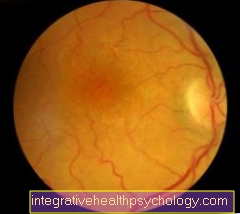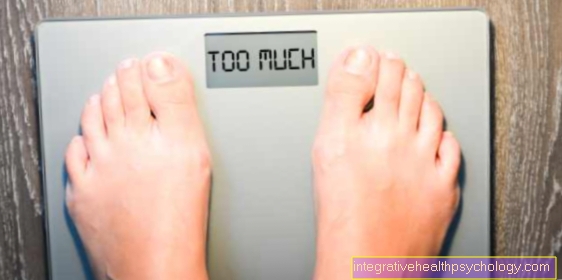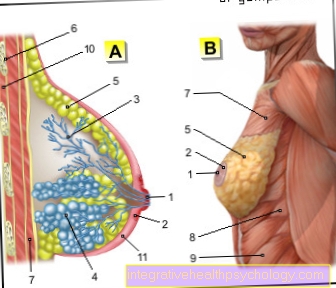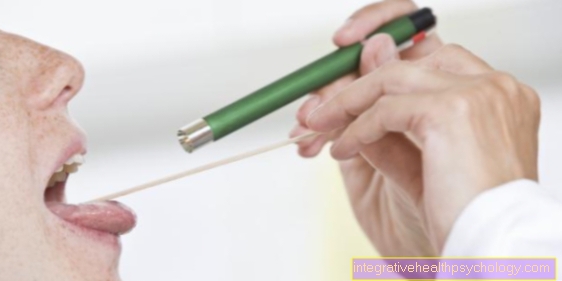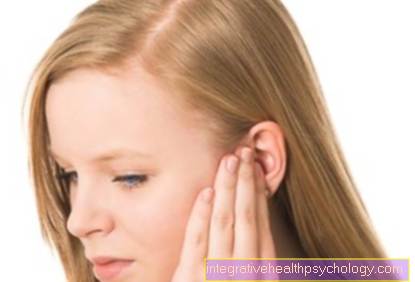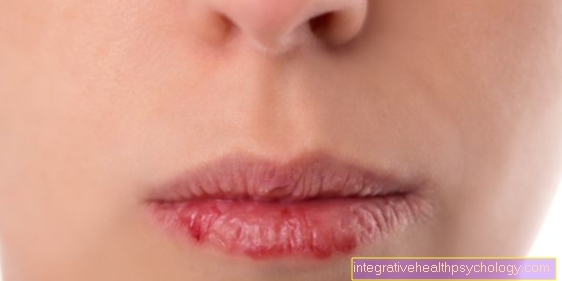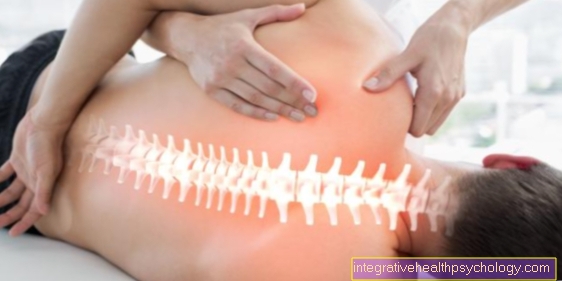Pain in jaw and ear
definition
Any pain that is in an area about the size of a fist around the ear can originate either in the ear or in the jaw. The close anatomical position of the jaw and ear to one another often causes pain in these two areas at the same time.
The temporomandibular joint is located visually in front of the external auditory canal and can be felt by placing the index finger in front of the ear. In addition, an important masticatory muscle - the temple muscle - pulls from the temple just in front of the external auditory canal to the lower jaw, so that even muscular tension can be mistakenly interpreted as ear pain.
Read more on the topic: Jaw pain

Causes of pain in the jaw and ear
If there is pain in the jaw and ear at the same time, it is important to find the exact origin of the pain. If the focus of the complaints is in the jaw, this is mostly due to a pathologically changed jaw joint.
In most cases, the lower jaw then does not lie optimally in its joint socket on the temporal bone and thus leads to a painful sensation in the ear area. Those affected mistakenly perceive this pain as pure earache, as it is projected in the area of the ear. Only when the pain occurs mainly when moving the jaw is the suspicion of a problem in the jaw directed.
The interface between the ear and jaw is also representative of the muscular tension in the masticatory muscles. In most cases, these are caused by clenching your teeth or grinding your teeth at night. It is not uncommon for stress and high psychological tension to play a role in the development of these phenomena.
But the teeth themselves and especially the wisdom teeth can cause severe pain in the area of the ear when the roots of the molars are irritated. They are innervated by branches of the fifth cranial nerve, which also supplies parts of the external auditory canal.
Much more specific, on the other hand, are pure earache, which is usually noticed as part of an infection. In these cases, however, a clear feeling of illness with fever and runny nose points the way.
Swelling in front of the ear, which leads to both ear and jaw pain, is more likely to indicate an inflamed parotid gland. They typically show up as a noticeable bump in front of the ear that can be sensitive to touch.
You might also be interested in: Temporomandibular joint pain
diagnosis
A first, trend-setting diagnosis can be made by the person concerned himself through a simple examination. To do this, the index fingers should be placed on the jaw joints in front of the ears and then the mouth should be opened and closed several times.
If those affected then feel a painful sensation in the jaw joint itself at the contact points of the fingers, this is more likely to indicate a problem with the jaw.
A subsequent inspection of the teeth can provide additional information.
In these cases, those affected should contact a dentist for further diagnosis. If, on the other hand, the symptoms occur with a ringing in the ear or hearing impairment, the ear, nose and throat specialist should be consulted for a medical assessment.
It should also be consulted if there are signs of infection such as fever or persistent pain in the ear area that is independent of movement.
Read more on the topic: Pain in the jaw and ear in the ENT
Accompanying symptoms of pain in the jaw and ear
The accompanying symptoms of pain in the jaw and ear arise from the cause of the discomfort.
Muscular tension in the masticatory muscles can be seen in pronounced symptoms through strong muscle tummies in the cheek area, which in extreme cases appear as "hamster cheeks". In addition, the pressing of the teeth on one another leads to wear on the teeth, which is shown by a change in the shape of the teeth.
It is not uncommon for the canine teeth to be abraded or even broken off after a certain period of time. Much earlier, however, unspecific headaches occur, which are particularly pronounced in the temple area.
This is due to the course of the temporal muscle, which runs from the temple to the lower jaw. If the muscle is permanently under tension, its starting point at the temple is irritated and leads to pain there.
If the teeth themselves are the cause of pain in the jaw, pain often occurs when eating and especially when eating foods that contain sugar.
If the ear is the cause of the pain, there are usually signs of infection. An otitis media, for example, often leads to fever and a general feeling of illness with a significant drop in performance.
In addition, it is not uncommon for hearing impairment to be observed, which can be seen in hearing loss or ringing in the ears.
Jaw and ear pain with swollen lymph nodes on the neck
Swollen lymph nodes on the neck usually indicate that the body's immune system is responding to an infection.
If jaw pain and ear pain are present at the same time, different structures come into consideration, which can be inflamed. Above all, it is teeth that can be infected, for example due to caries.
If the bacteria get into the bloodstream through the inflamed tooth, they are carried away with the bloodstream. The local lymph nodes in the neck area then recognize the pathogens as foreign and reactively initiate a defense reaction of the body. This involves attracting immune cells to the site of the action, which then settle in the lymph nodes. Those affected then notice this process in swollen lymph nodes. In itself, swelling of the lymph nodes due to inflammation is natural and should be observed during treatment.
If the swollen lymph nodes are associated with ear pain, this is more likely to indicate a concomitant infection of the upper respiratory tract with impairment of the middle ear. Here, too, the swollen lymph nodes represent an intact defense.
Read more on the topic: Neck lymph nodes swollen - how dangerous is it?
Jaw and ear pain with neck pain
Neck pain is often caused by muscular tension. In combination with jaw and ear pain, they tend to suggest a stress-related phenomenon.
If the person concerned is under stress, he automatically tenses his muscles more. With additional annoyance, this often leads to the teeth being pressed together and the back muscles to reactively tense up. The neck muscles tense mainly because of secondary headaches and can be seen as part of a vicious circle in the context of stressful states.
Jaw and ear pain with a sore throat
In most cases, sore throats are associated with infections. It is mainly viruses that lead to an infection of the upper respiratory tract and thus affect the ear, nose and throat area.
The reactive swellings of the mucous membrane then lead to insufficient ventilation of the middle ear and thus to ear pain.
Jaw and ear pain with toothache
Dental problems are a common cause of jaw and ear pain. This is mainly due to their anchoring in the jaw. Any spread of an inflammation of the teeth thus leads to an infection of the jaw if left untreated.
This is innervated by fibers of the fifth cranial nerve, which is responsible for the sensation of pain. However, some of its branches also lead to the ear and partially supply the external auditory canal. In this way, the pain can be projected onto the outer ear. But pain can also be mistakenly perceived as earache. The jaw receives its innervation from the temporomandibular joint to the chin and the upper jaw. If the inflammation progresses far enough, it reaches closer and closer to the temporomandibular joint and thus also to the ear.
Jaw and ear pain with problems with the wisdom teeth
Wisdom teeth are located behind normal molars in adult dentition. They often lead to tooth and jaw pain when they are about to break through the gums. It is typical that in this case the pain is described as dull and cannot be precisely localized in the back of the jaw. Signs of inflammation usually do not occur. The diagnosis is usually confirmed by an X-ray at the dentist.
You might also be interested in: Wisdom tooth pain
Therapy of jaw and ear pain
The therapy of ear and jaw pain is determined by the trigger. Inflamed teeth require treatment by the dentist. With the restoration of the teeth, the pain symptoms will quickly subside.
If the pain is caused by clenching of the teeth or teeth grinding, a bite guard and additional relaxation exercises can lead to a reduction.Here, however, the patient has to work for a successful therapy. Because only with a stress reduction will the tension-related pain decrease sustainably.
Misalignments of the jaw and degenerative diseases of the jaw must be corrected as well as possible. A dislocated jaw can be treated quickly and promises immediate pain relief, while an arthritic temporomandibular joint often requires drug therapy. It is generally important to keep moving the joint if you have jaw pain.
This includes regularly chewing on the same side and opening the mouth. Because every joint stiffens when it is not moved. Therefore, a reliever posture should not be taken for more than a few days and pain should be treated in good time with analgesics such as ibuprofen.
Infectious diseases of the ear also require drug therapy in most cases. The therapy is adjusted depending on the pathogen. Viral pathogens are treated symptomatically with decongestant nasal drops for upper respiratory tract infections and bacterial pathogens with antibiotics if necessary.
Duration of pain in the jaw and ear
Often, pain in the jaw and ear can be quickly resolved by the cause. If inflamed teeth are the cause, they will go away after treatment at the dentist. Muscular problems require the cooperation of the person concerned through gradual stress relief. If the internal tension persists, pain can only be reduced but not completely eliminated. In the case of an infection, on the other hand, the pain will subside as the healing process progresses and should generally not last longer than a week.
Jaw and ear pain when chewing
Pain when chewing is typical of inflamed teeth or a diseased temporomandibular joint.
Inflamed teeth show up as pain in one or more specific teeth and can be easily localized by the person affected. Pain in the temporomandibular joint, on the other hand, manifests itself depending on chewing or speaking movements in the area in front of the outer ear.
When the jaw is not used, there is usually no pain. A doctor must clarify whether it is a degenerative disease such as osteoarthritis or a dislocated jaw.
Jaw and ear pain up to the temple
If jaw pain extends to the temples, this suggests a muscular problem. Here, tension of the temporal muscle is obvious due to its anatomical location.
In order to perform its task of firing from the jaw, it pulls from the temple in front of the external auditory canal to the lower jaw. If the muscle is tense for too long or its function is overloaded, its fibers in the temporal area are irritated. In addition, the attachment point of the fibers can also trigger a pull on the skull bone and thus cause pain on top of that.




